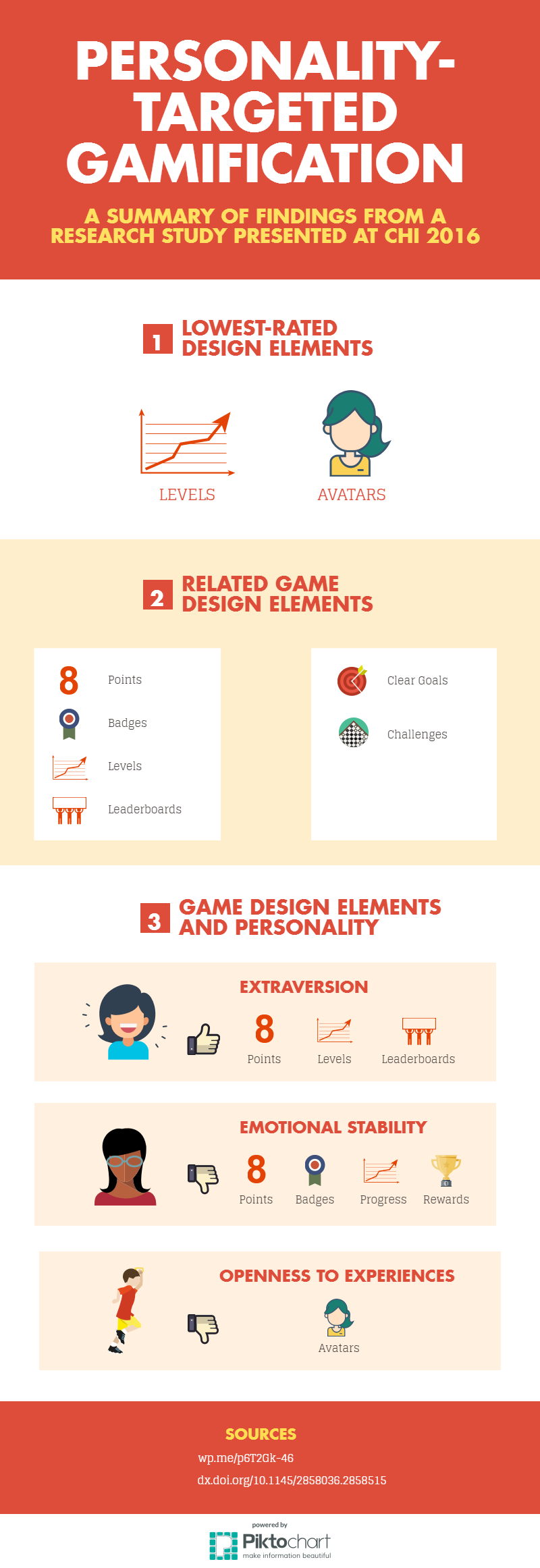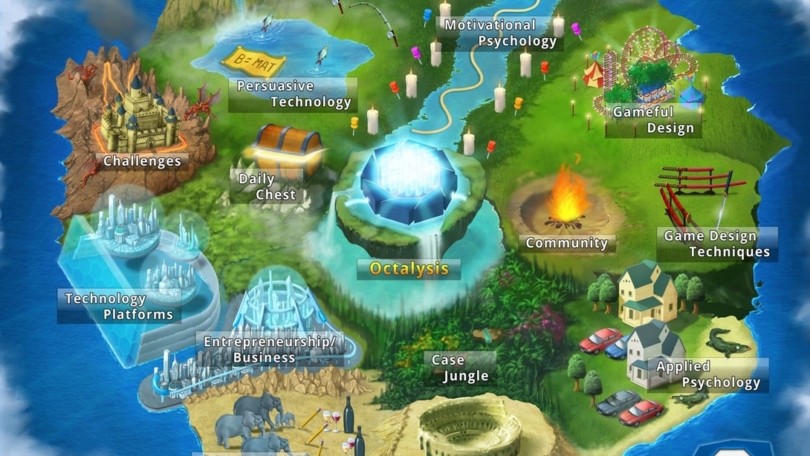Recently, a number of research studies have been investigating how to personalize gameful applications to each different user. One of these studies was presented at CHI 2016 and investigated how different people respond to various gamification approaches in health-related habit tracking applications.
The researchers asked 248 participants to rate how helpful and enjoyable different game design elements seemed to be. Additionally, they seek to understand if there was any relation between the participants’ preferences and their personality traits, measured by the Big-5 inventory. The study investigated 10 of the game design elements most commonly used in commercial gameful applications: points, levels, feedback, clear goals, leaderboards, challenges, badges, progress, rewards, and avatars.
Preferred Game Design Elements
Results showed that, overall, levels and avatars were the two lowest-rated design elements. Additionally, they showed that participants who preferred points often also preferred levels, badges, and leaderboards. This means that these game design elements might be used together for better results. However, participants also expressed concern with a perceived lack of value for these design elements, that is, they could be disconnected from the application’s main purpose. Therefore, the researchers suggest that when incorporating these elements into gamified self-tracking apps, they should be connected in some way to the main purpose of the application. For example, a level up could unlock advanced tracking features.
In contrast, clear goal was the best-rated design element. Participants who preferred to have clear goals also often enjoyed challenges. However, some respondents expressed concerns regarding these two elements due to the pressure of avoiding failing. Therefore, the researchers suggest that goals should be customizable and the system should help users set up sub-goals so that all goals may be difficult but attainable.
Employing Game Design Elements for Specific Personality Traits
Results showed that people who are more extraverted are more likely to prefer points, levels, and leaderboards. Therefore, these game design elements might be used for an app that should specifically appeal to users who are more extraverted. Furthermore, the researchers suggest using a leaderboard for a more sustained engagement because it allows users to engage with a dynamic social group.
People with high emotional stability (i.e., low neuroticism) rated all design elements lower, and particularly points, badges, progress, and rewards. Some of these participants rated the application as “just a toy” or “silly”. Hence, the researchers suggest that there might be a limit to what gamification can accomplish and it might not be an effective approach for those people with high emotional stability.
Finally, people with a high level of imagination and openness to experiences were less likely to be motivated by avatars. The avatar used in the study was too simple and made these participants feel bored. Therefore, the researchers suggest avoiding using avatars in conventional ways to appeal to users with high level of imagination.
These results add up to the growing body of research showing that personalized gamification approaches have a greater potential than one-size-fits-all approaches. Several other studies have been presented or are yet scheduled to be presented this year regarding the personalization of gameful applications. Follow us to receive more news about this topic in the future!
Original publication: Yuan Jia, Bin Xu, Yamini Karanam, and Stephen Voida. Personality-targeted Gamification: A Survey Study on Personality Traits and Motivational Affordances. ACM CHI 2016.





3 Comments
wed
Hi,
I am aiming to design an adaptive gamification system based on the big five personality. However, I found a few theories that mapped gamification elements with Big five personality except two or three research at most.
I believe that conscientiousness and Agreeableness can be satisfied with most of gamification elements if we exclude the leaderboard in some personalities. but what about neuroticism?I mean users with high neuroticism, what is the best gamification element can match with their personality and can motivate them? Do you suggest any. I tried to focus on this personality and tried to find elements that can help them
Gustavo Tondello
Indeed, there aren’t many studies connecting personality traits with gamification elements yet.
Have you already looked at our newer post, The Gamification User Types Hexad Scale? There you can find connections of the five personality traits with the Hexad user types, and then with game design elements. For example, emotional stability/neuroticism influences one’s tendency to be a Free Spirit or Disruptor, so elements like Exploration, Non-linear gameplay, Creativity or Development tools, Innovation, etc. can help. I recommend you also read the full research paper on the topic.
Additionally, let me give you an idea. I don’t know your rationale for using the big five personality traits to adapt your gameful system, but have you considered using a gamification user type model instead? Although personality traits certainly influence user preference for different elements, the user types model is created specially for this purpose, so it might be able to better capture this kind of user preference. The Hexad user types model can be used for this purpose and now there’s a validated questionnaire that you can use to find a person’s user type. Here are some links where you can learn more about it:
http://www.gamified.uk/user-types/
http://gamified.uk/UserTypeTest2016/user-type-test.php
https://www.gamefulbits.com/2016/09/14/gamification-user-types-hexad-scale/
https://hcigames.com/download/the-gamification-user-types-hexad-scale
wed
Thanks for replying. I appreciate this hard work. I looked to these types. I am using the adaptation based on personality because my Phd thesis is based on how gamification can enhance the motivation for learners. I first used the adaptive learning system based on personality and measure how the adaptation can optimize the performance and other measurement. Then, I will add the adaptive gamification on the same system to examine the effect of the adaptive gamification elements. So, I want to use the result I received from my first experiment without increasing the number of questionnaires and tests to users. But, I think I need to double check these references.
Thank you so much